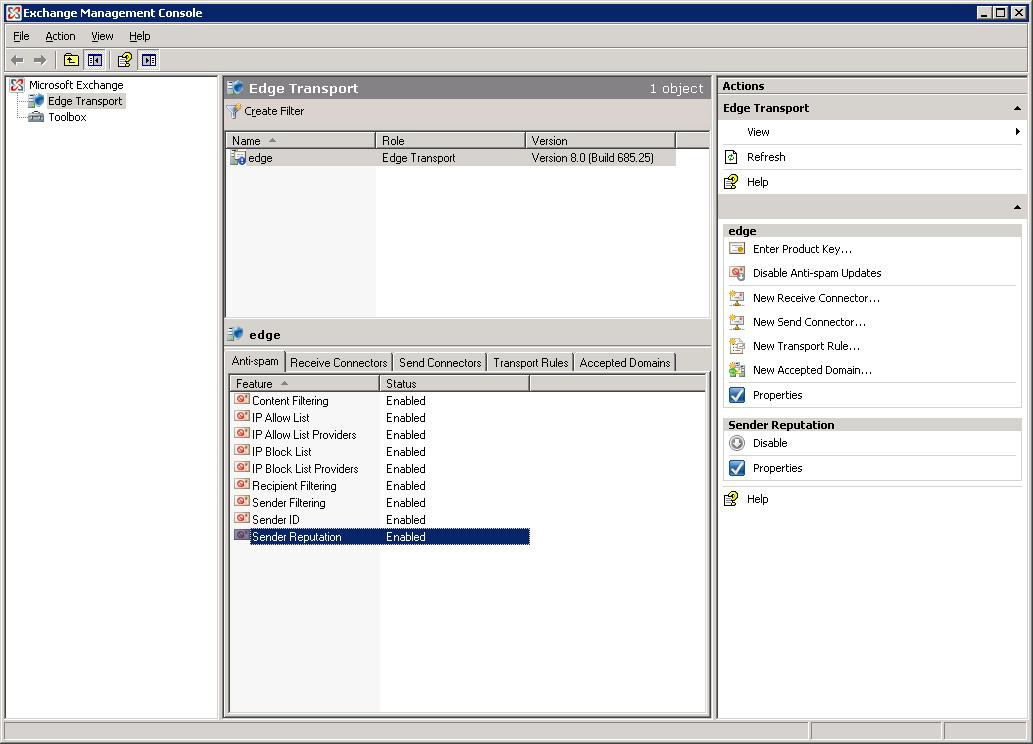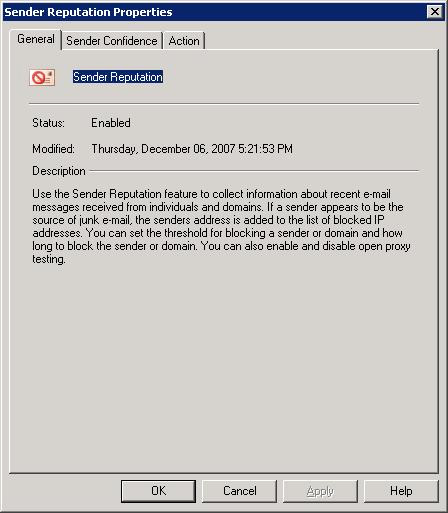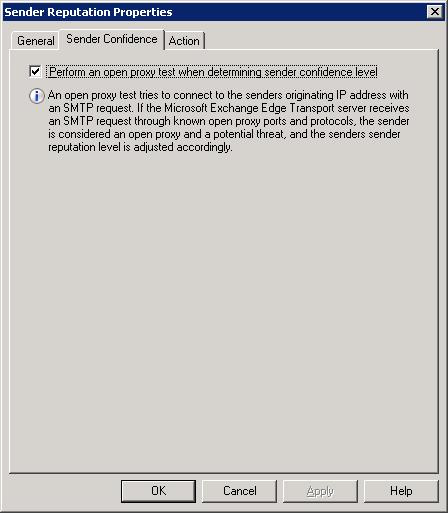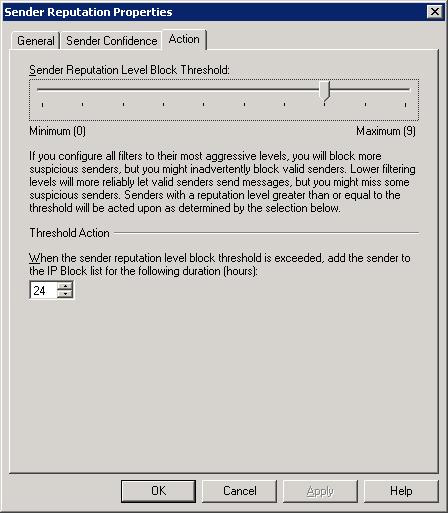Limit Spam with the Sender Reputation in Exchange 2007
TipsMake.com - In email management and classification systems, the detection and prevention of spam messages are always top priority. For years, Microsoft has been conducting research, building and developing many anti-spam mechanisms and integrating into their Exchange Server products, and one of them is Sender Reputation Filtering . In the following article, we will explain some of the main features and mechanisms of this Sender Reputation Filtering feature.
In terms of nature, the process of filter filter activity Sender Reputation is quite simple, by sorting and filtering information coming from the sender account, thereby deciding whether it is spam or not. But technically, the above process can be done in many ways. Specifically, Sender Reputation will 'look' at the most visible parts of the email such as the header, actions related to the same account in the history . Through such classification classes, the system has reduced the load. pretty much spam data.
Sender Reputation Filter works primarily in Edge Transport Servers , designed primarily to work with Exchange Server, and exist between the Internet environment and the rest of the Exchange Server system . With the main function is to filter content components, spam data and contain malicious code before they can enter the main system. In addition, the Sender Reputation Filter is always enabled in default mode, and users do not need to configure and set up too much.
One of the first operations of Sender Reputation is to try to determine that the sender's address spoofs any HELO / EHLO component when the ESMTP process is executed. You need to know that one of the most basic actions of a hacker is to regularly use various HELO / EHLO structures, which also contain fairly secretive 'embedded' IP addresses. If this address does not match the IP address from the email, it is more likely that the email is spam.
Next is to check the mail server of the sender's address to determine if there is an open proxy component. If so, they will be classified as spam because spammers often use this method and take advantage of the way the open proxy works.
Another point to keep in mind is that this open proxy will also be related to open relay. When Exchange Server starts the test of open proxy, the system will forward the email back to the sender's mail server address. If the Edge Transport Server receives this test message, the mail server is sure to have an open proxy . More specifically, Exchange uses HTTP Connect, HTTP Post, Telnet, Wingate, SOCKS 4, and SOCKS 5. Note that in order for this test to complete, you must open port 1080, 1081, 23, 6588, 3128, and 80 on the firewall system.
Finally, the Sender Reputation Filter checks the most recent activity of the sender. Each inbound email is assigned with a Sender Confidence Level indicator - corresponding to the percentage of messages that are spam.
Next, we will go into the setup and customization process in the Exchange Management Console at the Edge Transport Server. When the main control panel starts, select the Edge Transport, the middle pane will display all the filters that are available on the system:

Next, right-click Sender Reputation> Properties from the menu, and the entire attribute information Sender Reputation Properties will display as shown below:

We can easily see that the General tab provides quite a bit of detail and details about Sender Reputation Filtering, and users cannot edit this information. You continue to switch to the next tab section - Sender Confidence:

Here, the user will have a number of options to perform open proxy checks - this feature is already enabled by default, if you want to turn it off, just uncheck here. .

And finally, the Action tab allows us to set up and create different Sender Reputation levels. When the sender's value exceeds the parameter that you have pre-configured, the address will be immediately assigned to the block list - Block at a fixed time.
Through some basic features described briefly above, Sender Reputation Filter can completely be considered as one of the simplest weapons to fight spam that is increasingly expanding on the Internet today. . Good luck!
You should read it
- Exchange 2007 anti-spam function conversion tool
- Automatically identify and delete spam emails in Outlook with Spam Reader
- Exchange Server 2007's spam filtering feature does not need the Exchange Server 2007 Edge Server
- Beware of the 7 most common types of spam
- Instructions to delete spam automatically in Gmail
- Instructions to transfer emails from Yahoo! Mail to GMail
- Instructions to block mail senders in Gmail
- Delete the old SMTP domain from the Exchange 2007 mailbox
May be interested
- Move mailboxes between IMAP servers with IMAPcopy
 imapcopy allows you to recursively copy all email messages and folders from another imap account. it supports imap and imaps protocols. in this article we will guide you to move mailboxes between imap servers using imapcopy.
imapcopy allows you to recursively copy all email messages and folders from another imap account. it supports imap and imaps protocols. in this article we will guide you to move mailboxes between imap servers using imapcopy. - Install and configure Mailman (with Postfix) on Debian Squeeze
 mailman is a free open source software used to manage mailing lists, it can be used in managing email discussions and newsletters.
mailman is a free open source software used to manage mailing lists, it can be used in managing email discussions and newsletters. - Virtualize users and domains with Postfix, Courier, MySQL and SquirrelMail
 postfix is a mta (mail transport agent), written by wietse venema when he was working at ibm's tj watson research center. postfix features: easy to manage, fast, safe ...
postfix is a mta (mail transport agent), written by wietse venema when he was working at ibm's tj watson research center. postfix features: easy to manage, fast, safe ... - Step by step install Exchange Server 2010
 facing the increasing demands of organizations and businesses in exchanging information, so that they both save costs, operate faster, are more manageable, more reliable and better security. ..
facing the increasing demands of organizations and businesses in exchanging information, so that they both save costs, operate faster, are more manageable, more reliable and better security. .. - Move mailboxes between IMAP servers with IMAP TOOLS
 imap tools is a collection of perl scripts, allowing you to do many different tasks with imap server as well as pop3. in the following article we will guide you to move mailboxes between imap servers using imap tools.
imap tools is a collection of perl scripts, allowing you to do many different tasks with imap server as well as pop3. in the following article we will guide you to move mailboxes between imap servers using imap tools. - Configure, set Incoming and Outgoing Email on SharePoint 2010 - Part 1
 in the tutorial article below, we will introduce you to some basic steps to set up the rules applicable to incoming and outgoing emails via microsoft sharepoint 2010. application, for example, when enabling incoming feature sharepoint email, system members can automatically store emails and attachments that they send to addresses
in the tutorial article below, we will introduce you to some basic steps to set up the rules applicable to incoming and outgoing emails via microsoft sharepoint 2010. application, for example, when enabling incoming feature sharepoint email, system members can automatically store emails and attachments that they send to addresses






 Exchange 2007 anti-spam function conversion tool
Exchange 2007 anti-spam function conversion tool Exchange Server 2007's spam filtering feature does not need the Exchange Server 2007 Edge Server
Exchange Server 2007's spam filtering feature does not need the Exchange Server 2007 Edge Server What is spam? How is it understood in Zalo, LoL, Facebook ...
What is spam? How is it understood in Zalo, LoL, Facebook ... Limit sending and receiving mail in Exchange 2007
Limit sending and receiving mail in Exchange 2007